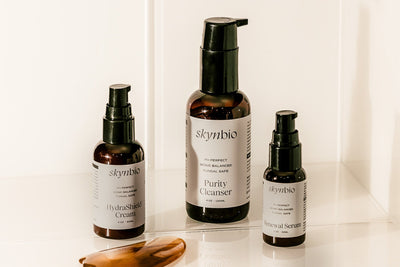When your skin flares up, it’s natural to look for quick solutions, especially if it looks like acne. But here’s the truth: not all breakouts are bacterial acne. Many people struggling with recurring bumps, itchiness, and persistent breakouts are actually dealing with fungal acne (also known as Malassezia folliculitis). The frustrating part? Common acne prescriptions like antibiotics, benzoyl peroxide, and heavy moisturizers can make things worse.
In this post, we’ll break down why these incorrect prescriptions can trigger flare-ups, how to spot if your routine is sabotaging your skin barrier, and what you can do to restore balance using microbiome-safe, oil-free skincare.
Step 1: Understand the Root Cause It’s Not Always Bacteria
Most acne prescriptions are designed to kill bacteria or reduce oil production. But fungal acne isn’t caused by bacteria it’s caused by yeast (Malassezia), a microorganism that naturally lives on your skin. When this yeast overgrows often due to excess oil, heat, or humidity it clogs pores and leads to uniform, itchy bumps that don’t respond to traditional acne treatments.
That’s where the problem starts: incorrect prescriptions for fungal acne target the wrong enemy, damaging your skin barrier and microbiome in the process.
Step 2: The Pitfall of Antibiotics
Antibiotics are one of the most common prescriptions for acne, but they can backfire on fungal acne-prone skin. Here’s why:
- They kill good bacteria, disrupting your skin’s delicate microbiome.
- This imbalance allows yeast (Malassezia) to thrive, worsening fungal acne.
- Overuse leads to redness and a compromised barrier.
Instead of calming your skin, antibiotics often make fungal acne-prone skin more irritated. This is why many people experience short-term relief but long-term flare-ups after antibiotic treatments.
Step 3: The Problem with Benzoyl Peroxide
Benzoyl peroxide is a go-to for bacterial acne, but for fungal acne, it’s like adding fuel to the fire. It oxidizes quickly, drying out the skin and creating micro-cracks that weaken your natural barrier. This damaged barrier becomes an open door for yeast imbalance and irritation.
It also increases irritation, making your skin sting or peel. In contrast, fungal-safe routines focus on barrier repair and microbiome balance not aggressive exfoliation or stripping.
Step 4: Heavy Moisturizers Hidden Triggers in Disguise
When your skin feels dry, your instinct might be to reach for rich, creamy moisturizers. Unfortunately, many of these contain fatty acids, esters, or oils that feed Malassezia. These ingredients become a buffet for yeast, worsening the very condition you’re trying to calm.
The solution? Choose oil-free, microbiome-safe moisturizers that hydrate without feeding the overgrowth. Skynbio’s HydraShield | Oil-Free Moisturizer is formulated specifically for fungal acne-prone and barrier-challenged skin providing lightweight moisture while protecting against flare-ups.
Step 5: Rebuilding Balance The Microbiome-Friendly Way
To reverse the effects of incorrect prescriptions for fungal acne, focus on restoring your skin’s balance instead of fighting it. That means:
- Using a pH-balanced cleanser that respects your skin’s natural microbiome.
- Applying a biome-friendly serum that supports barrier repair.
- Sealing in moisture with an oil-free, non-comedogenic moisturizer.
Consistency and gentleness are key your skin doesn’t need harsh correction; it needs balance and microbiome harmony.
Additional Tips and Common Mistakes to Avoid
- Check ingredient labels: Avoid products containing esters, polysorbates, and coconut oil they’re known Malassezia triggers.
- Be patient: Fungal acne healing takes time. Sudden changes or too many actives can delay recovery.
- Keep your environment clean: Wash pillowcases and masks frequently to prevent yeast buildup.
- Support your gut health: A balanced diet helps maintain a healthy skin microbiome from within.
Bottom Line
Incorrect prescriptions for fungal acne like antibiotics, benzoyl peroxide, and heavy moisturizers can create a cycle of imbalance, irritation, and recurring breakouts. The key to lasting results isn’t stronger treatments but smarter ones that respect your microbiome and support your barrier.
Start with the Clear Balance Trio
At Skynbio, our science-backed, oil-free, microbiome-safe skincare helps you achieve calm, balanced, and resilient skin without triggering fungal acne. Each formula is designed to work in harmony with your natural flora so your skin can heal, not hide. Try our Purity Cleanser, Renewal Serum, and HydraShield Moisturizer your microbiome-safe essentials for lasting clarity and balance.




